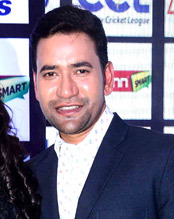The Ganga , or Ganges, formerly also spelled Gunga, is one of the largest rivers in India.
Contents
Ganga may also refer to:
The Ganga , or Ganges, formerly also spelled Gunga, is one of the largest rivers in India.
Ganga may also refer to:
Krishna is a Hindu deity.
Kalyani may refer to:
Sita is the consort of Lord Rama and an avatar of Sri Lakshmi, the Hindu goddess.

Arrah is a city and a municipal corporation in Bhojpur district in the Indian state of Bihar. It is the headquarters of Bhojpur district, located near the confluence of the Ganges and Sone rivers, some 24 miles (39 km) from Danapur and 36 miles (58 km) from Patna.
Satya is a central concept in Indian religions that loosely translates into English as "Truth". Satya, Sathya, Satyam or Sathyam may refer to:
Ganges is a river in India.

Ganga Jamna, also transliterated as Ganga Jamuna or Gunga Jumna, is a 1961 Indian crime drama film, written and produced by Dilip Kumar, and directed by Nitin Bose, with dialogues written by Wajahat Mirza; Kumar later said that he also ghost-directed and edited the film. It stars Dilip Kumar with Vyjayanthimala and his real-life brother Nasir Khan in the leading roles. Set in the rural Awadh region of Northern India, the film tells the story of two impoverished brothers, Ganga and Jamna, and their poignancy and sibling rivalry on opposing sides of the law, one a dacoit criminal and the other a police officer. The film was also notable for its Technicolor production, use of the Awadhi dialect, and its rustic setting, being a defining example of the dacoit film genre. It was ranked 11th in Outlook Magazine's poll considering 25 leading Indian directors' vote for Bollywood's greatest films in 2003.

Vyjayanthimala Bali, known mononymously as Vyjayanthimala, is an Indian parliamentarian, dancer and former actress. Regarded as one of Hindi cinema's finest actresses and dancers, she is the recipient of several accolades, including five Filmfare Awards and two BFJA Awards. Considered the first female superstar of Indian Cinema, she made her screen debut at the age of 16 with the Tamil film Vaazhkai (1949), and followed this with a role in the Telugu film Jeevitham (1950). Her first work in Hindi cinema was the social guidance film Bahar (1951), which she headlined, and achieved her breakthrough with the romance Nagin (1954).
Sangam or Sangama may refer to:

The cinema of Bihar, a state in eastern India, primarily consists of films in the Bhojpuri language. Bihar also has smaller Maithili- and Magahi-language film industries. Cinema in the state began during the early 20th century.
Ganga Maiyya Tohe Piyari Chadhaibo is a Bhojpuri film released in 1963 directed by Kundan Kumar. It was the first-ever Bhojpuri film, and starred Kumkum, Ashim Kumar and Nazir Hussain. It had music by Chitragupta, lyrics by Shailendra and songs sung by Lata Mangeshkar and Mohammad Rafi. The film is based on author Acharya Shivpujan Sahay's short story Kahani Ka Plot.
Bihari culture refers to the culture of the Indian state of Bihar. Bihari culture includes Angika culture, Mithila culture, Bhojpuri Culture and the culture of Magadha.

Bhojpuri cinema, also known as Bhojiwood, and the Bhollywood, is the segment of Indian cinema dedicated to the production of motion pictures in the Bhojpuri language widely spoken in Bihar and eastern Uttar Pradesh. Its major production centres are Patna. Bhojpuri cinema has grown in recent years. Bhojpuri cinema also caters to second and third generation emigrants who still speak the language in Guyana, Trinidad and Tobago, Suriname, Fiji, Mauritius and South Africa.
A rishi in Indian religions is an accomplished and enlightened poet of Vedic hymns.
Narasimha is an avatar of the Hindu god Vishnu.
Gunga may refer to:

Dinesh Lal Yadav, popularly known as Nirahua, is an Indian actor, singer, producer and politician associated with Bhojpuri-language films. He is among the most successful Bhojpuri actors, with successive five box office successes released in 2015. He owns the production house Nirahua Entertainment Pvt Ltd. Dinesh Lal Yadav was a contestant on Bigg Boss 6 in 2012.
Nazir Hussain was an Indian actor, director and screenwriter. He was famous as a character actor in Hindi cinema and was a pioneer of Bhojpuri cinema. He acted in almost 500 films, with Dev Anand starring in a large proportion of the films he acted in.
Anna may refer to:
Awdhesh Mishra is an Indian actor who primarily works in Bhojpuri-language films, mainly in negative roles. He has worked as main villain in several Bhojpuri films, few Tamil and Bollywood as well.